

The Interactive Computing Facilities Committee and the Engineering Board have recommended that GEC 4070 mini-computers should be installed in the following institutions to widen the distribution of interactive computing services:
The recommendations have been approved by SRC and are now awaiting formal approval by the Department of Education and Science.
Initially the 4070s will have HASP connections to the 360/195s at Chilton. Later, X25 protocols will be used to link them to the GEC 4080 network node computer at Chilton instead. This will permit interactive use of one mini from terminals attached to another, file transfer between any two minis and remote job submission to the 360/195s. Other terminals on the Interactive Facility network will also be able to access the 4070s. The minis may also be connected to their local campus networks so that they can use facilities such as magnetic tape drives and card readers which will not be provided on the minis themselves.
We hope to have the X25 links working by Christmas.
As reported in Rapid Response No.6, the Interactive Computing Facility has purchased an AP120B processor from Floating Point Systems Incorporated. to be attached to the PRIME 400 computer at Chilton. More than 400 of these machines have already been delivered (30 in the UK) and they are used extensively in signal processing, image analysis, simulations, molecular dynamics etc.
The AP120B is a high-speed pipeline processor which works in parallel with a host computer. It achieves its speed by using simple components with very complex interconnections, enabling many different operations to be carried out at the same time; eg there are three separate memories for programs, constants, and data which can all be accessed simultaneously. There are separate floating-point multiplier and adder units which enable each of these arithmetic operations to be started once every 167 nanoseconds. In a typical calculation. eg a Fast Fourier Transform, all the computation can be overlapped with data memory access time. The performance obtained depends greatly on the nature of the problem, and speeds between 0.3 and 2.5 times that of the IBM 360/195 have been quoted in some calculations.
Available software consists of a library of FORTRAN-callable subroutines to perform vector and matrix manipulations, Fast Fourier Transforms etc in the AP120B, and to transfer data to and from the host computer. Additional subroutines to be executed in the AP120B may be written by the user in AP assembly language, and these may be called from the FORTRAN program running in the host machine. Later in the year a FORTRAN compiler will be available to enable programs written in FORTRAN to run in the AP120B.
The version we have ordered has 64K words of data memory, 2.5K words of read-only table memory, and 1K words of program memory. It will be delivered at the end of July and is intended to come into service in October. Members of the Finite Element and Electromagnetic Applications Special Interest Groups, and others, are currently adapting programs for the AP120B. Any people with programs which they feel could exploit the power of the AP120B, or who would like further information, should contact Dr A D Bryden at the Rutherford Laboratory.
During the last few years, the availability of cheap graphical displays has allowed easier communication between the computer and the user. Also, the increasing availability of access to interactive facilities has made them more attractive to the control system designer. The well-established techniques developed by Nyquist, Bode, Nichols, and Evans all rely heavily on information presented in graphical form, and are ideally suited for implementation on interactive computing facilities with graphical displays. Recent developments in multi-input/multi-output control system design methods, which essentially consist of generalisations of the "classical methods", are also well suited to such implementations. These latter techniques depend entirely on the use of a digital computer to carry out the necessary calculations, which are both complex and tedious. The prime results of these calculations are presented to the control system designer in graphical forms. They provide information about the system performance and give useful guidance on how this performance can be changed by the use of feedback action and suitable compensators.
In addition to design tools, the control engineer needs facilities which will a!1ow the data defining a system model to be readily entered into the computer in a variety of forms. He needs to manipulate this data into other forms suitable for analysis, design, and simulation studies.
A large set of overlaid FORTRAN IV programs, all operating in an interactive conversational mode, have been implemented for this purpose on the DEC-10 computer at UMIST. These facilities allow the designer to apply several different design approaches rapidly to a given problem. They also allow a much improved continuity of thought compared with batch mode operation, and should lead to better and simpler solutions to control problems.
The facilities currently available consist of the following:
The design suite is well documented. A User's Guide provides illustrative examples of all the currently available facilities. A Programmer's Guide gives details of the programming conventions used throughout the suite and so allows future expansion by the user without the need to rewrite development programs.
The Control Systems Centre at UMIST has successfully applied the computer-aided control system design suite to a number of industrial design problems. It has also been sold internationally to several major industrial concerns by the Centre on behalf of NRDC.
The above report was provided by Dr Neil Munro of the Control Systems Centre, UMIST. Readers who would like more details or who would like to use the software should get in touch with him.
ABACUS is a research unit within the Department of Architecture and Building Science at the University of Strathclyde in Glasgow. It was set up about seven years ago and has since been engaged in research and development on Computer Aided Design software for the architectural and building professions. Most of the research funding (totalling £1.5m) has been provided by SRC and the software was developed on the UNIVAC 1108 computer at the National Engineering Laboratory, East Kilbride. Early this year the unit completed the transfer of all its development work to the Edinburgh DEC-10.
At present ABACUS is in the middle of a 5 year SRC-supported programme of combined research and development: ten researchers (architects, engineers, systems analysts and programmers) are working on 8 major projects. Other software (about 20 packages) developed over the past seven years is also supported.
Some of the developments now underway are:
ESP - Environmental Systems Performance: an interactive simulation package performing an hour-by-hour analysis of the dynamic thermal behaviour of buildings. Subsystems deal in detail with lighting levels, detailed design of the plant configuration etc (see Fig 1).
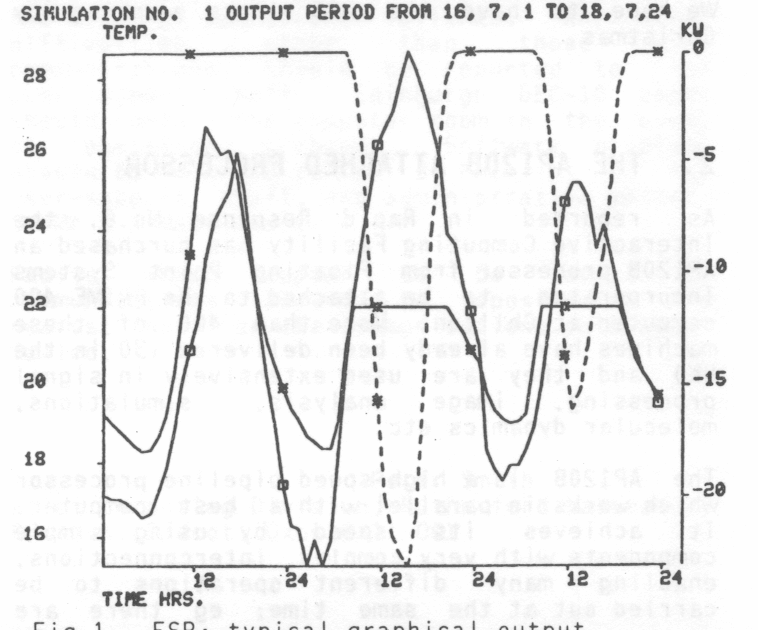
BILD - Building Integrated Layout Design: a building design package for the scheme/detail design stage in the building process. A complex model of the building resides in a large data base and is accessed by applications modules giving graphical display or evaluations of cost, planning etc (see Fig 2).
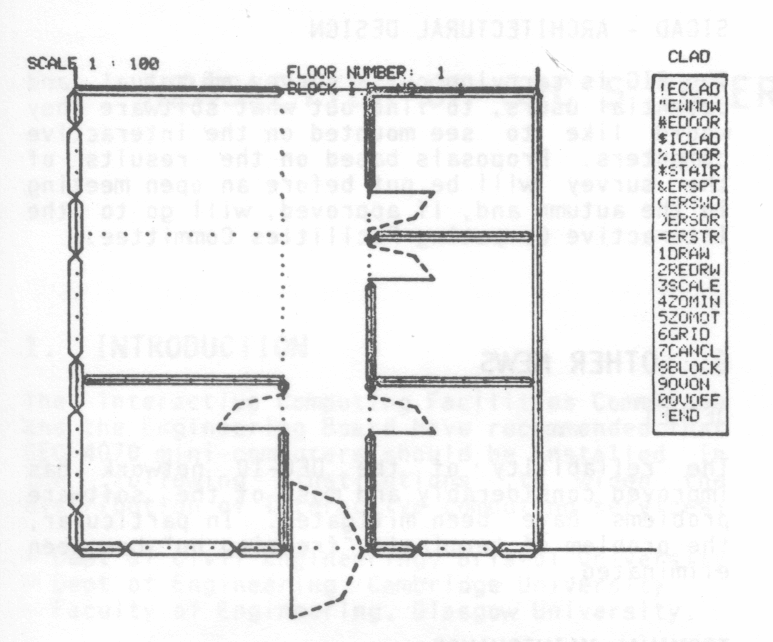
PARTIAL: Participation in Architectural Layouts; a building design package for use at the early stages of design (brief formulation and sketch layouts). This is being used in psychological and statistical tests of the abilities of 'naive' designers (and people new to computers) to design a building eg nursery schoolteachers designing a nursery school (see Fig 3).
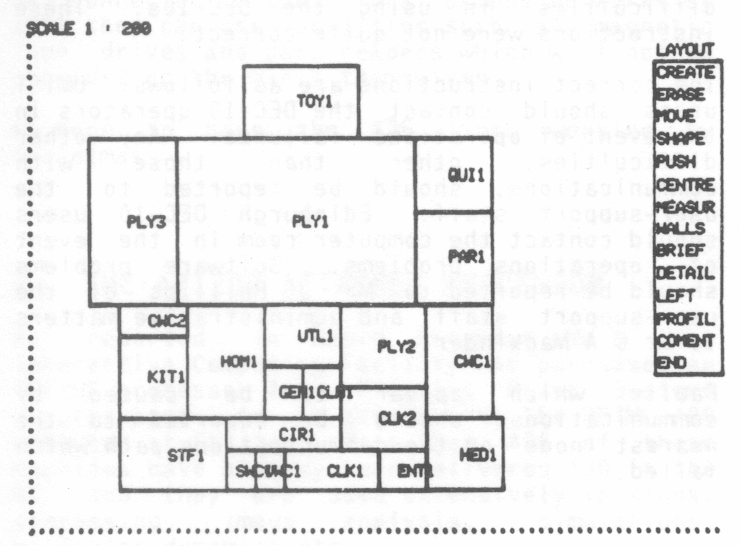
Since the programs are intended for eventual use by end-user architects on their own computers or via a bureau, they are written in 'standard' (transportable) FORTRAN to operate simply on Tektronix storage tube terminals via the TEKPLOT control software. For development work ABACUS has Tektronix 4010 and 4014 terminals, various peripherals such as a digitiser, and a Nova 820 minicomputer. Access to Edinburgh is via three fixed GPO private circuits.
A typical project results in a CAD program incorporating a 'model' of the proposed design of a building and facilities for changing the design, possibly graphically. It also includes appraisal or evaluation of important features, for example capital cost, energy consumption or planning efficiency. The programs do not design or optimise the complex multi-variate design problem, but provide information to the designer for systematic decision-making.
CAD in architecture involves an increased Quantity and Quality of information and also the discipline imposed by systematic evaluation. This feature has not been as readily accepted by architects as by engineers. For this reason significant effort has been put into encouraging feedback about use of the programs by user/designers, and also into implementing the programs in practice, and validating the results. NRDC are supporting a sales/marketing exercise aimed at proving the practical value of the software. The interface at the terminal between user and program has been of fundamental importance and normal interactive dialogue is supported by interactive graphics with menu picking for function and program control (see Figs 4 and 5).
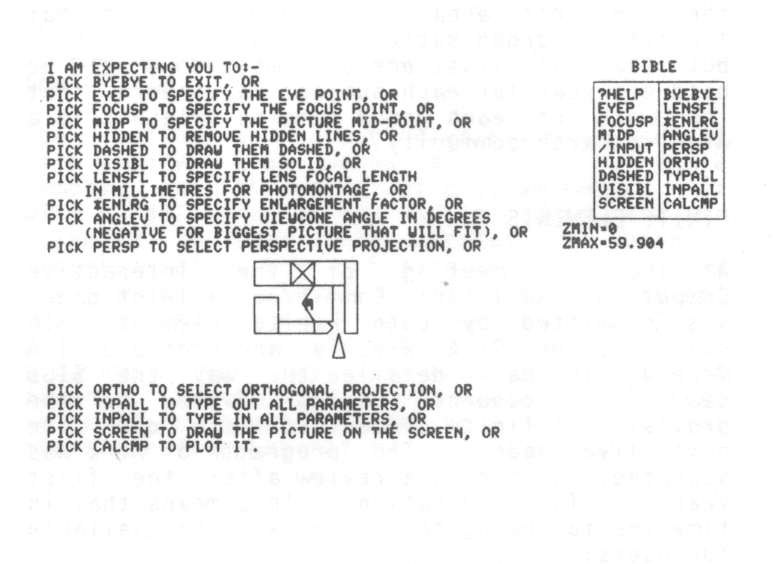
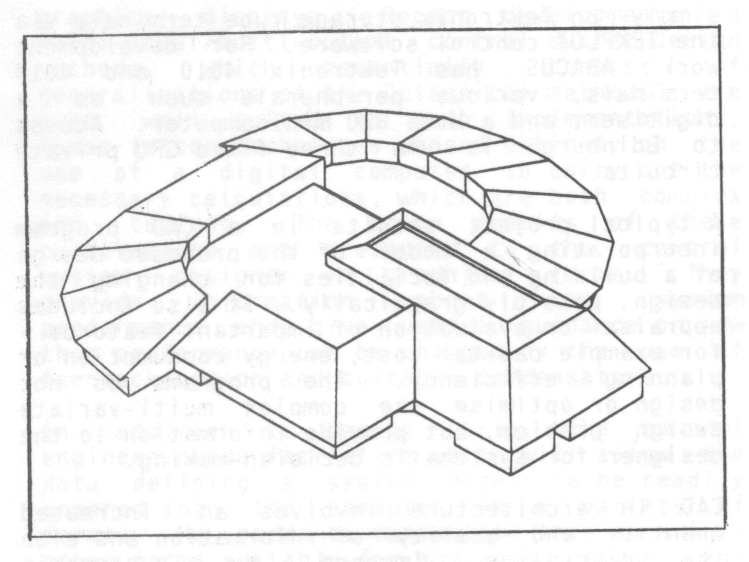
Harvey Sussock of ABACUS provided this report. Readers interested in more details about ABACUS should get in touch with him.
The Interactive Computing Facilities Committee has considered how best to retain access to research expertise through the SIGs after they have submitted formal proposals for applications software at the end of their first year's work. Some SIGs have suggested a reduction in their membership to a steering group of two or three experts who will monitor work undertaken by the Interactive Facility in their subject area. The Committee felt that the form of organisation should be flexible, but that at least one open meeting should be held per year for each subject to ensure that the work of each group remains relevant to a wide research community.
At the last meeting of the Interactive Computing Facilities Committee, a joint paper was submitted by both Finite Element SIG chairmen, Dr C A Brebbia and Professor I A Mcleod. The paper detailed the way the SIGs saw SRC resources being devoted to the provision of finite element software over the next five years. The programme of work was accepted, subject to a review after the first year of full operation. This means that in time the following facilities will be available for users:
Four FE packages are currently being investigated at Rutherford. If sufficient staff can be obtained, a fully-supported service should be available in the autumn. The Finite Element Library will be at two levels:
The SIG is carrying out a survey of actual and potential users, to find out what software they would like to see mounted on the interactive computers. Proposals based on the results of the survey will be put before an open meeting in the autumn and, if approved, will go to the Interactive Computing Facilities Committee.
The reliability of the DEC-10 network has improved considerably and most of the software problems have been mitigated. In particular, the problem of terminals "freezing up" has been eliminated.
Many terminals located away from the Rutherford Laboratory are being maintained and serviced by Cable & Wireless under a contract. We have little feedback about how well it is being done. Any user who has experience of this good or bad - is invited to report it to Mike Jane at the Rutherford Laboratory.
In Section 9 of the last issue there were some instructions about what to do in the event of difficulties in using the DEC-10s. These instructions were not quite correct.
The correct instructions are as follows: UMIST users should contact the DEC-10 operators in the event of operations failures. Any other difficulties, other than those with communications, should be reported to the user-support staff. Edinburgh DEC-10 users should contact the computer room in the event of operations problems. Software problems should be reported to Mr J Phillips of the user-support staff, and administrative matters to Mr C A Mackinder.
Faults which appear to be caused by communications should be reported to the nearest 'node' on the communications path which failed.